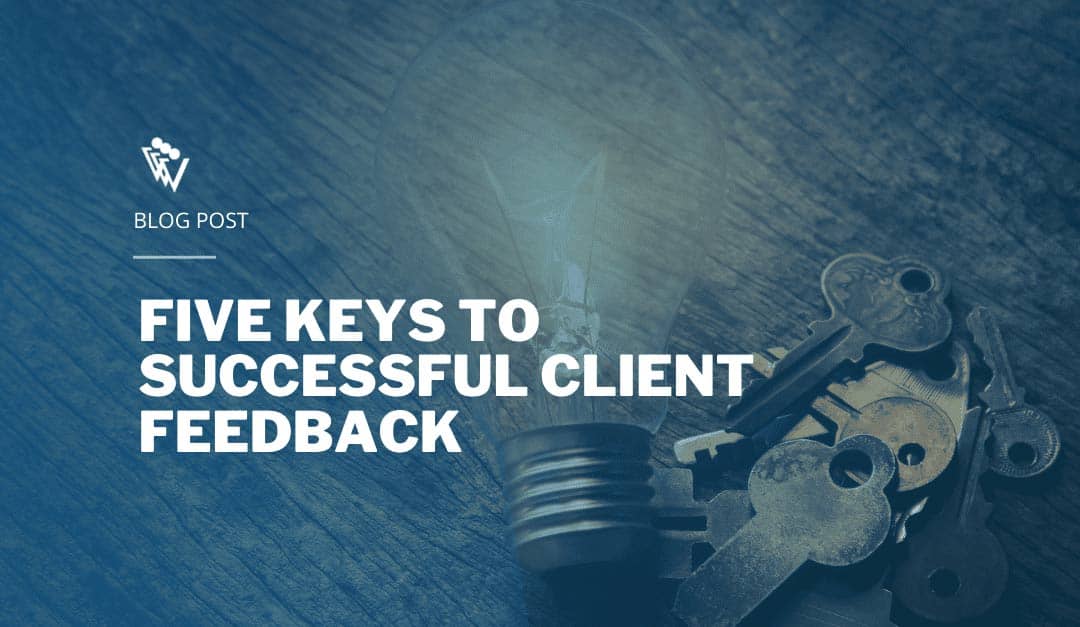Get feedback early, often, from everyone, interpret, and respond.
Over the past 17 years, Client Savvy has gathered successful client feedback from more than one million clients of over 500 professional services companies spanning 20 time zones. Here are five things to consider when creating a data-driven client experience management program:
Get Feedback Early
All projects are a series of events. Let's say you're helping a client with a project that has 8-events. At event 5, there was an issue. While problem was solved, and the project was successful, you only asked for feedback one time at the end of event 8. Because of this, most people put a “but” in the feedback. The problem, though already resolved, still looms over you like a gray cloud. The scores you collect reflect more about the minor failure than the project's ultimate success.
Let’s take the same eight-step project, but this time we implement a regular feedback system. We don’t necessarily collect feedback and measure every event. That would be overkill, but we measure often enough to find problems and root them out as the project continues. In this scenario, you still have the same problem, and you still fix it. However, since the measurement occurred so close to when the problem occurred, it's contained in real-time. Now, when you get to the end, no one's looking to rehash the problem. Your final measurement to reveal the true success of the project. It’s a more accurate measure.
Get Feedback Often
Project progress is typically experienced through meetings, phases, and deliverables. The client journey follows these milestones.
When you get feedback along the client’s journey, you can discover issues early and fix them. WIth that, we can discover unknown successes and can perpetuate them. This creates additional perceptions of value as the project progresses. By project end, your clients perceive they got more value than they expected. Since the largest invoices often occur toward the end of the project, there’s no better time to submit a big bill to a client than when your stock price is selling at its highest.
Not all projects are the same. A three-week project will never support seven measurements. A three-year project may need twice that number.
We’ve found clients respond at a high rate – around 50% - up to about eight feedback requests per year per person. That may sound like a lot, but consider eight requests per year, with a 50% response rate, which means your clients are responding about four times per year. That’s about once per quarter. What client doesn’t want to invest 8-10 minutes a year to make all his or her projects better?
Get Feedback From the Right People
It’s helpful to have a picture of the overall feedback ecosystem and all of the stakeholders therein.
Rather than feedback happening only between marketing or a principal, we recommend deploying feedback in a way that matches how your project relationships are built. Begin at the bottom of the org chart, and flow up to leadership.
You increase accountability and responsibility, you have more candid results, and leadership is in a supporting role to help staff when needed, rather than in a defensive role of pushing challenges down.
Also, consider peers, project partners, sub-consultants, and contractors – all players involved throughout the project. They may work with your competitors, they may know what others do well, and will often share with you competitive intelligence if you ask.
Additionally, asking sub-consultants how well you are doing can help them do their best work for you. You are the client in this situation, but you can take a leadership role in improving outcomes for everyone. Besides, when you ask a sub for feedback, they are much more likely to ask you (their client) for some feedback from you. There’s no better way to give feedback than to ask for it first.
Who else can cause problems on the project? Perhaps a general contractor, or some other downstream service provider. If you frequently find yourself at odds with a stakeholder, even if you do not have any direct financial link, asking for feedback can surface issues early so you can head them off. If you are the one to present challenges to the client, with your own context and with solutions already in mind, that heads off any other party from surprising you and throwing you under the bus.
The feedback ecosystem can get quite large – we encourage you to start smaller, with a focus on one particular area. Then, as you develop expertise and momentum in the program, begin expanding the scope to include more stakeholders.
When you put it all together, you end up with a simple plan – one page or so, detailing what events might trigger a feedback request, the timing relative to that event, who should ask, who they send it to, and what set of questions best match up to that event. We work to keep the plan simple, clear, and sufficiently nuanced to be potent.
Don’t Worry About Scores
Scores only matter as much as they help tell you when to engage with a client to capture their story. A formal feedback survey should never replace a conversation with a client, but it should facilitate the conversations that need to happen. It’s these conversations that create stories. The stories create the learning you’re after and the insights to help grow your business. Remember, scores tell you more about the client than they’ll ever tell you about yourself.
If you or a member of your team struggle to accept challenging feedback, reframe your focus. Instead of focusing inward on yourself, ask “Interesting, I wonder why she said that?” By reframing critical feedback as context about the client, you promote curiosity and empathy, which lead to deeper understanding and more effective development of healthier relationships.
Follow-Up Quickly
You can and should take the listening process even further. Proactively follow-up with clients after receiving feedback.
Our Client Feedback Tool gives you the option to document and capture what follow-up steps you took in response to feedback. Here's a Client Listening case study with some great results.
The act of documenting follow-up is highly correlated to improving performance versus expectations for clients.
We’ve measured thousands of client relationships over the years, and observed that those who take time to document follow-up reduce their rate of repeat low scores by 83% compared to those who don’t capture any follow-up.





